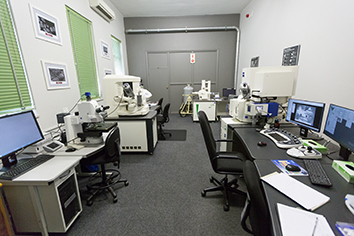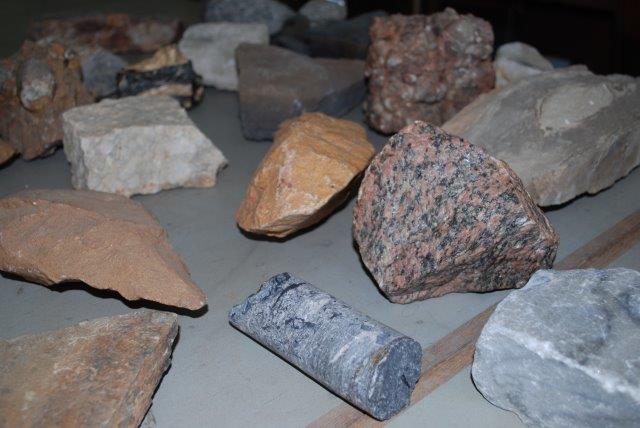Information for postgraduate research students
Use of laboratories and instruments in the department and the Central Analytical Facility for your research
ALWAYS make yourself acquainted with the general SAFETY & SECURITY RULES in the laboratories and the building !
CENTRAL ANALYTICAL FACILITY
The Central Analytical Facilities (CAF) manages most analytical instrumentation that you are likely to use at Stellenbosch University. Many of the relevant instrument laboratories are actually located within the Chamber of Mines building (e.g. SEM, ICP) and some are located in other University buildings (e.g. XRF). You can find out what is available and whom to contact about access to a particular facility by visiting the CAF web site: https://www.sun.ac.za/english/faculty/science/CAF
This site also contains forms for sample submission to certain facilities. For access to all CAF units and instrument training and support, students need to register as a CAF user and receive a unique CAF ID: http://www0.sun.ac.za/safmachform/machform/view.php?id=73618
 The three SEMs in the Chamber of Mines Building (room 1034/1035) are managed by Prof. Lydia-Marie and two senior analysts – please contact them directly if you need to use the instruments. The Zeiss MERLIN has 8 different detectors and is used for high resolution SE (Secondary Electron), BSE (Backscattered Electron), EDS (Energy-Dispersive X-ray Spectroscopy), CL (cathodoluminescence) and STEM (Scanning Transmission EM) imaging. The Zeiss EVO is used mainly for elemental analysis using EDS and WDS (Wavelength Dispersive Spectroscopy) as well as for SE and BSE imaging. Both MERLIN and EVO instruments also have a cryo stage to stabilize samples and improve resolution.
The three SEMs in the Chamber of Mines Building (room 1034/1035) are managed by Prof. Lydia-Marie and two senior analysts – please contact them directly if you need to use the instruments. The Zeiss MERLIN has 8 different detectors and is used for high resolution SE (Secondary Electron), BSE (Backscattered Electron), EDS (Energy-Dispersive X-ray Spectroscopy), CL (cathodoluminescence) and STEM (Scanning Transmission EM) imaging. The Zeiss EVO is used mainly for elemental analysis using EDS and WDS (Wavelength Dispersive Spectroscopy) as well as for SE and BSE imaging. Both MERLIN and EVO instruments also have a cryo stage to stabilize samples and improve resolution.
At the EM Unit group training is provided once a month as a one-day course, followed by one-on-one sessions using the students' own samples, until they are proficient to use the instruments independently. Students sign up for training online (http://blogs.sun.ac.za/sem/) and for assisted EM analysis they need to contact the unit before booking the instrument and an analyst on the scheduler. Training and support in sample preparation are also provided.
(Electron microbeam lab of the central analytical facility)
In other cases (ICP-MS, LA-ICP-MS and XRF) you need to contact the CAF staff member responsible for the particular analytical facility to book time on instruments (LA-ICP-MS) or to have samples collected for XRF. Find their contact details here: https://www.sun.ac.za/english/faculty/science/CAF.
For all units: Make contact well in advance, as some instruments are being used constantly and have long waiting lists.
Never book analytical time without receiving prior approval to do so from your supervisor. All instrument time is charged for and you have to check that your supervisor is providing funds to cover this. If you book instruments without supervisor's permission, covering the associated costs, even for cancelling the reservation, remains with you.
Training in analytical techniques, data reduction and interpretation is a fundamental part of a research degree. The extent of student participation within CAF varies, depending on the technique used. For example, after appropriate training, you can expect to be involved in all your imaging and collection of EDS/WDS mineral major-element compositions using the SEM, X-ray maps and all data reduction. On the contrary, for XRF you will not be running the instrument but, depending on the level of your supervisor's funding, you may have to crush and powder the samples yourself.
Note that, in early February, there will be a short introduction to CAF facilities and analytical methods given as part of the Honours course. Provided space is available, other postgrads (M and D) are welcome to take part in this course.
SAMPLE PREPARATION
Certain CAF facilities are specifically equipped for sample preparation. These include our rock cutting, grinding, crushing and polishing (e.g., in lab 1022), as well as mineral separation facilities (in the rear quad). Access to these, particularly the mineral separation, grinding and polishing facilities is controlled and you need to make appointments through the online-booking system: skedda.com. To get a Login and be added to the relevant group, please contact Mareli Grobbelaar. She will also provide you with necessary training and oversight.
 For the saw lab please contact George Olivier. Please keep rock preparation areas clean. Failure to do so may result in the contamination of your samples or those of others. It will also result in denial of further access to preparation areas. If a facility is broken, either by you or others, please report this immediately to the Departmental Technical Officer (Mr George Olivier). It can take quite a while to order replacement parts and/or service machinery and severe delays will eat into your research time.
For the saw lab please contact George Olivier. Please keep rock preparation areas clean. Failure to do so may result in the contamination of your samples or those of others. It will also result in denial of further access to preparation areas. If a facility is broken, either by you or others, please report this immediately to the Departmental Technical Officer (Mr George Olivier). It can take quite a while to order replacement parts and/or service machinery and severe delays will eat into your research time.
For thin sections please consult your supervisor. We have limited provision for making polished thin sections in the department but, in many cases, thin sections are outsourced to laboratories in other institutions. Whether produced here or elsewhere you will certainly be involved in cutting rock samples into thin section briquettes.
DEPARTMENTAL FACILITIES
Some additional facilities that you may need to use fall under the control of the Department of Earth Sciences. The most important of these are:
Field Store
This contains a variety of equipment that is available for use in the field and for camping. However, the equipping of undergraduate field trips must take precedence over your possible needs. If you wish to use something you need to approach the Senior Technical office, Mr George Olivier.
Research Microscopy Laboratory (room 2037)
This facility houses the research-grade petrological microscopes, the photomicroscope and the A3 flatbed scanner. The Department's Senior Technical Officer (Mr George Olivier) oversees access. Always replace the microscope covers after using. Do not consume food or drink in this lab. If you wish to scan a solid specimen, always place a sheet of clear plastic between the sample and the glass on the scanner. Report any problems to Mr Olivier, immediately and police each other's use of this lab as well.
Environmental Geochemistry Research Laboratory (room 1015)
This lab is exclusively for the use of students working on projects supervised by Prof. Roychoudhury. Prof. Roychoudhury is the responsible member of staff. Access is restricted.
Ultra-clean Laboratory (in rear quad)
This lab is under the strict control of Prof. Roychoudhury and is only used for highly specialised sample preparation and analysis. Access is restricted.
Experimental Petrology Laboratory (in rear quad)
This laboratory houses high-pressure and high-temperature apparatus of various kinds, used to investigate Earth materials properties and behaviour at deep-Earth conditions. The equipment is the joint property of Profs Gary Stevens and John Clemens. Access is restricted to specially trained students working with one of these two staff members.
Geological Compasses, GPS units and Geiger Counters, etc.
The Department has a stock of such items that you may be able to take into the field. The needs of the undergraduate fieldwork programme take precedence, however. If you would like to take such equipment for your own fieldwork, you need to talk with the Senior Technical Officer (Mr George Olivier), who has custody of these things and can arrange for the forms, etc. that you will need to complete to borrow them.
Other Facilities
In addition to the facilities above, individual supervisors may give you access to personal research equipment that they own (e.g., microscopes, slide scanners and special field equipment). It is your responsibility to see that you have the appropriate knowledge and training to use these things safely and without damaging them. Your supervisors will provide that training.
High-Resolution Slide Scanner (for thin sections or colour transparencies)
Access to this piece of equipment is a special case. Although it is the joint personal property of Profs Buick, Stevens and Kisters, they are prepared to accord research students access to it. If you need to use this, you should approach Prof. Ian Buick. If access is granted, you will then need to arrange for access to Prof. Gary Stevens's office, as that is where this equipment is housed.

